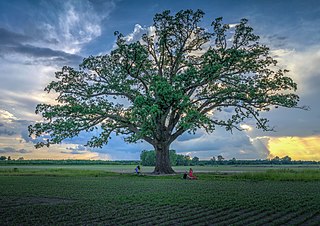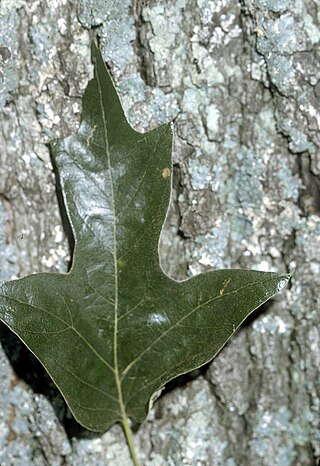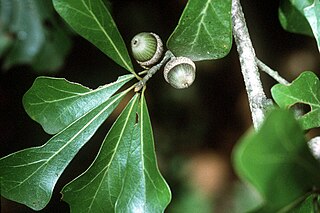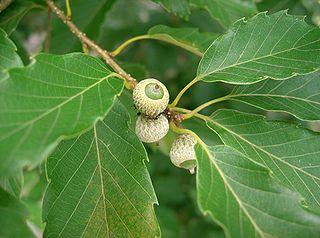
Quercus montana, the chestnut oak, is a species of oak in the white oak group, Quercus sect. Quercus. It is native to the eastern United States, where it is one of the most important ridgetop trees from southern Maine southwest to central Mississippi, with an outlying northwestern population in southern Michigan. It is also sometimes called rock oak because of its presence in montane and other rocky habitats.

Quercus palustris, also called pin oak, swamp oak, or Spanish oak, is a tree in the red oak section of the genus Quercus. Pin oak is one of the most commonly used landscaping oaks in its native range due to its ease of transplant, relatively fast growth, and pollution tolerance.

Quercus bicolor, the swamp white oak, is a North American species of medium-sized trees in the beech family. It is a common element of America's north central and northeastern mixed forests. It can survive in a variety of habitats. It forms hybrids with bur oak where they occur together in the wild.

Quercus cerris, the Turkey oak or Austrian oak, is an oak native to south-eastern Europe and Asia Minor. It is the type species of Quercus sect. Cerris, a section of the genus characterised by shoot buds surrounded by soft bristles, bristle-tipped leaf lobes, and acorns that usually mature in 18 months.

Quercus macrocarpa, the bur oak or burr oak, is a species of oak tree native to eastern North America. It is in the white oak section, Quercus sect. Quercus, and is also called mossycup oak, mossycup white oak, blue oak, or scrub oak. The acorns are the largest of any North American oak, and are important food for wildlife.

Quercus michauxii, the swamp chestnut oak, is a species of oak in the white oak section Quercus section Quercus in the beech family. It is native to bottomlands and wetlands in the southeastern and midwestern United States, in coastal states from New Jersey to Texas, inland primarily in the Mississippi–Ohio Valley as far as Oklahoma, Missouri, Illinois, and Indiana.

Quercus laevis, the turkey oak, is a member of the red oak group of oaks. It is native to the southeastern United States. The name turkey oak derives from the resemblance of the leaves to a turkey's foot. A Turkish and southern European species Quercus cerris is also commonly referred to as Turkey oak, so Quercus laevis is sometimes referred to as American turkey oak to distinguish it from the European species.

Quercus laurifolia is a medium-sized semi-evergreen oak in the red oak section Quercus sect. Lobatae. It is native to the southeastern and south-central the United States.

Quercus trojana, the Macedonian oak is an oak in the turkey oak section (Quercus sect. Cerris).

Quercus falcata, also called southern red oak, spanish oak, bottomland red oak or three-lobed red oak is an oak. Native to the southeastern United States, it gets its name the "Spanish Oak" as these are the areas of early Spanish colonies, whilst "southern red oak" comes from both its range and leaf color during late summer and fall. The southern red oak is a deciduous angiosperm, so has leaves that die after each growing period and come back in the next period of growth.

Quercus shumardii, the Shumard oak, spotted oak, Schneck oak, Shumard red oak, or swamp red oak, is one of the largest of the oak species in the red oak group. It is closely related to Quercus buckleyi, Quercus texana, and Quercus gravesii.

Quercus gambelii, with the common name Gambel oak, is a deciduous small tree or large shrub that is widespread in the foothills and lower mountains of western North America. It is also regionally called scrub oak, oak brush, and white oak.

Quercus coccinea, the scarlet oak, is a deciduous tree in the red oak section Lobatae of the genus Quercus, in the family Fagaceae.

Quercus ellipsoidalis, the northern pin oak or Hill's oak, is a North American species of oak tree native to the north-central United States and south-central Canada, primarily in the Great Lakes region and the Upper Mississippi Valley. It most commonly occurs on dry, sandy soils.

Quercus lyrata, the overcup oak, is an oak in the white oak group. The common name, overcup oak, refers to its acorns that are mostly enclosed within the acorn cup. It is native to lowland wetlands in the eastern and south-central United States, in all the coastal states from New Jersey to Texas, inland as far as Oklahoma, Missouri, and Illinois. There are historical reports of it growing in Iowa, but the species appears to have been extirpated there. It is a slow-growing tree that often takes 25 to 30 years to mature. It has an estimated lifespan of 400 years.

Quercus variabilis, the Chinese cork oak, is a species of oak in the section Quercus sect. Cerris, native to a wide area of eastern Asia in southern, central, and eastern China, Taiwan, Japan, and Korea.

Quercus castaneifolia, the chestnut-leaved oak, is a species of oak in the turkey oak section Quercus sect. Cerris. It is native to the Caucasus and Alborz mountains of Iran, and resembles the closely related Turkey Oak in appearance.

Quercus nigra, the water oak, is an oak in the red oak group, native to the eastern and south-central United States, found in all the coastal states from New Jersey to Texas, and inland as far as Oklahoma, Kentucky, and southern Missouri. It occurs in lowlands and up to 450 meters in elevation.

Quercus serrata, the jolcham oak, is an East Asian species of tree in the beech family. It is native to China, Taiwan, Japan, and Korea.

Quercus hartwissiana, the Strandzha oak, is a species of oak, native to southeastern Bulgaria, northern Asia Minor along the Black Sea, and the Caucasus. It was described by the Finnish-born Russian botanist and entomologist Christian von Steven in 1857.























